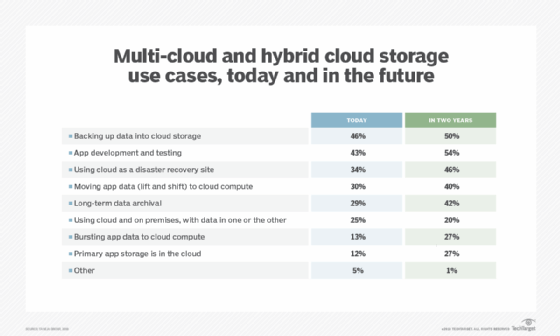
tashatuvango - Fotolia
4 hybrid cloud use cases that can help enterprises
A hybrid cloud can be more trouble than it's worth, but that doesn't mean your IT team shouldn't consider it. Learn about the most common examples where this approach makes sense.
Hybrid cloud gets a lot of attention, but the majority of effort in this space centers on a small set of use cases.
Hybrid clouds are interconnected environments that span private data centers and public clouds such as AWS, Microsoft Azure and Google Cloud Platform. They're designed for enterprises that need or want to keep certain assets on premises while still taking advantage of the elasticity and on-demand services available through the public cloud.
However, hybrid clouds shouldn't be confused with hybrid IT, which pertains to siloed workloads hosted in different environments -- a scenario the vast majority of enterprises have adopted in some form. For example, a business might have its ERP systems inside its private data center and a web application on AWS. Yes, IT teams face challenges in managing these disparate environments, but the workloads themselves are not reliant on one another.
Instead, hybrid clouds require some level of interdependence between public and private environments. This creates complexities around latency, security and workload parity that greatly limits the number of practical hybrid cloud use cases.
Here are the top use cases where a hybrid cloud might make sense, as well as some insights from industry analysts to help frame the requirements, advantages and challenges associated with making each one work.
1. High availability and DR
While not the most exciting of hybrid cloud use cases, high availability and disaster recovery are definitely among the most common ones, said Melanie Posey, an analyst at 451 Research.
In this scenario, an IT team mirrors its on-premises implementation in the cloud, much like a traditional warm DR site. If the private data center stops operating normally, applications could failover to the cloud environment and continue to run without any noticeable disruption to users.
This approach can be taken a step further for organizations that want to architect their hybrid clouds for high availability. In this permanent arrangement, load balancers distribute traffic between on-premises and cloud environments as needed.
However, this hybrid cloud use case does have its limitations. The cost to run two mirrored environments is often prohibitive and can be overkill for many workloads. It also requires environment parity, which limits your ability to utilize cloud-based services.

2. Migrations to and from the cloud
The scope of this hybrid cloud use case depends on whether you view a migration as a stopgap measure or a permanent connection between your data center and the cloud. If it's the latter, it's similar to the HA/DR strategy in that your intention is to create an insurance policy of sorts for your workloads. But instead of guarding against hardware and software failures, you're guarding against vendor lock-in.
"This use case is semi-permanent for an application that might need to be migrated and then theoretically, you could move it back if needed," Posey said.
This could be achieved by connecting to a target cloud over dedicated fiber connections or through VPNs. Alternatively, in the case of AWS, you could use Outposts to support portability between the public cloud and private data centers.
In practice, though, enterprises rarely migrate production applications back on premises, Posey said. The hybrid aspect occurs as the migration is tested and evaluated. Eventually, these workloads become fully cloud-based applications.
For those only concerned about migrating to the cloud, they can still utilize a hybrid cloud -- albeit temporarily. That's because the process isn't as simple as flipping a switch, said Deepak Mohan, an IDC analyst. It can take months to complete, with many rounds of migration and validation. "When you think about migration and cloud adoption for big companies, it is a long-term process and they often need the flexibility to be able to roll back a change," he said.
In this scenario, a hybrid cloud is beneficial because you can start the move without changing everything at once, Mohan said. For example, you can work to get the right level of consistency in behavior between on premises and the cloud. IDC recently surveyed 1,500 enterprise IaaS users and found that one of the top reasons for moving apps to and from the cloud was to ensure they were set up optimally.
Hybrid cloud tools you can use
For each of these use cases, there are several general types of tools that will support a hybrid cloud, said Tracy Woo, a Forrester analyst. These include:
- Cloud management tools to manage across multiple cloud and non-cloud environments.
- Cloud cost optimization tools to help control costs across cloud and non-cloud environments.
- Cloud migration tools to assess workloads when they're shifted from one deployment model.
- Cloud monitoring tools to assess cloud performance both in steady-state and in transition.
3. Application lifecycles
Many organizations got their feet wet in the cloud with dev and test projects, which remains a common hybrid use case, Posey said. Dev and test environments have been popular for cloud users for years because IT teams can set up -- and take down -- sandbox environments faster and cheaper on a public cloud. On premises, they need to go through a procurement process to get the appropriate hardware and software, which can take months.
Once applications are ready for production, they're either moved on premises or deployed into production on the public cloud.
4. Data center extension
In this scenario, on-premises servers handle the primary load, with the public cloud providing important support. The healthcare sector is a prime model for this hybrid cloud use case, Mohan said. For example, IT support for patient monitoring might need to be on premises for latency purposes, but an organization could combine that information with other large data sets in the cloud. Using the cloud as a back end, that data can then be analyzed to support advanced diagnostics.
Privacy constraints can also drive a company to use the cloud as an extension of its data center. Some data sets can't be put in the cloud due to internal policies or government mandates regarding movement of data across borders. When workloads can't be moved, organizations will put what they can in the cloud -- especially to address public-facing latency issues for distributed end users -- but the rest stays on premises, Mohan said.
Another example would be a traditional central data repository that sits on premises, with various associated applications and workloads deployed into the public cloud. Those cloud-based workloads either draw data into the repository or pull it out as needed. The entire arrangement is then integrated and presented to the end users as a seamless whole.
Vendors such as VMware have focused on this data center extension approach, offering a self-contained universe with built-in tools to help with setup and management, Posey said. An IT team that uses VMware could have some VMs on premises and some off premises, through one of VMware's many partnerships with public cloud providers. From there, everything is handled by vCenter. "That takes care of all the orchestration and cost optimization and so on," Posey said.
Alternatively, you can take a do-it-yourself approach, where you have all your different cloud resources and you go to a third party like Flexera. "There, you basically take all your different cloud capabilities and resources and plug them into the third-party software and deal with it that way," Posey said.






